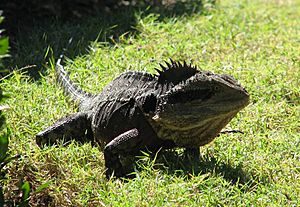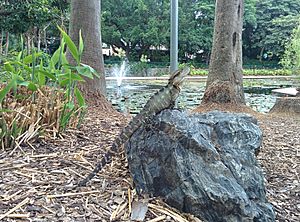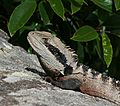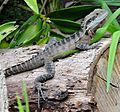Australian water dragon facts for kids
Quick facts for kids Australian water dragon |
|
|---|---|
 |
|
| Intellagama lesueurii lesueurii | |
 |
|
| Intellagama lesueurii howittii | |
| Scientific classification | |
| Genus: |
Intellagama
|
| Species: |
lesueurii
|
| Subspecies | |
|
|
| Synonyms | |
|
|
The Australian water dragon (Intellagama lesueurii) is a cool lizard that lives in eastern Australia. It's known for living near water and climbing trees. This species includes two main types: the eastern water dragon (Intellagama lesueurii lesueurii) and the Gippsland water dragon (Intellagama lesueurii howittii). You can find them from Victoria up to Queensland. There might even be a small group living in South Australia that was brought there by people.
Contents
What's in a Name?
The scientific name for the Australian water dragon, lesueurii, was chosen to honor a French naturalist named Charles Alexandre Lesueur. A naturalist is someone who studies nature.
What Do They Look Like?
Australian water dragons have strong legs and sharp claws. These help them climb trees easily. They also have a long, powerful tail that is flat on the sides, which is perfect for swimming.
They have cool spikes on their neck and back. The spikes on their neck are called a nuchal crest. These spikes continue down their spine, getting smaller as they go towards the tail.
- Size:
- Female water dragons can grow to about 60 centimeters (2 feet) long, including their tail. Their tail makes up about two-thirds of their total length!
- Males can grow even bigger, sometimes over one meter (39 inches) long, and can weigh about 1 kilogram (2.2 pounds).
- Males usually have brighter colors and bigger heads than females. Young water dragons don't have very bright colors.
Different Types of Water Dragons
The Australian water dragon is the only species in its group, called Intellagama. But there are two main types, or subspecies:
- The eastern water dragon (Intellagama lesueurii lesueurii) often has white, yellow, or red on its throat. It also has a dark stripe behind its eye.
- The Gippsland water dragon (Intellagama lesueurii howitti) doesn't have the eye stripe. Instead, it has dark stripes on the sides of its throat, which might have yellow, orange, or blue spots.
Both types are usually a light greenish-grey color. They have black bands across their back, tail, and legs. Water dragons can slowly change their skin color to help them blend in with their surroundings, like a chameleon! They also shed their skin as they grow, just like snakes.
How Do They Behave?
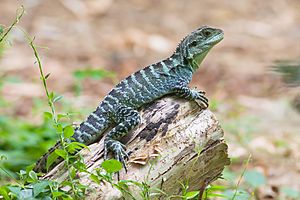
In the wild, Australian water dragons are quite shy. But if they get used to people, like in parks or gardens, they can become quite comfortable. They are very fast runners and excellent climbers.
If a water dragon feels threatened by a predator, it will quickly hide in thick plants. Or, it might drop from a branch into the water below. They can swim completely underwater and even stay at the bottom of shallow creeks or lakes for up to 90 minutes to avoid being seen!
Both male and female water dragons do special actions like:
- Basking: Lying in the sun to warm up.
- Arm-waving: Moving their arms in a special way. Fast arm-waving shows they are in charge, while slow arm-waving means they are giving in to another dragon.
- Head-bobbing: Moving their head up and down.
Male water dragons are very protective of their space. If there are many dragons in one area, males might act aggressively towards other males. This can include showing off, chasing, and even fighting.
Having Babies
Australian water dragons that live in cooler parts of Australia will go into a deep sleep, called hibernation, during winter.
In spring, usually around October, the female water dragon digs a burrow. This hole is about 10 to 15 centimeters (4 to 6 inches) deep. She then lays between 6 and 18 eggs inside. The nest is usually in sandy or soft soil, in a sunny spot. After laying the eggs, she covers the hole with soil and loose bits of nature.
A cool fact about water dragon babies is that their sex (whether they will be male or female) is decided by the temperature of the nest! This is called temperature-dependent sex determination.
When the baby dragons hatch, they stay near the entrance of their burrow for a while. Once they leave the nest, they tend to stick together in groups, away from the adult dragons.
Where Do They Live?
As their name suggests, Australian water dragons love water! They are semi-aquatic, meaning they spend time both in water and on land. You can find them near creeks, rivers, lakes, and other water bodies. They need places to bask in the sun, like branches hanging over the water or rocks.
They are very common in the rainforest part of the Brisbane Botanic Gardens, Mount Coot-tha in Queensland. There's even a monument built there to honor them!
There are also stories of a small group living far from their usual home, in the Forest Range area of South Australia. These dragons were probably brought there by someone who liked reptiles in the 1980s.
Who Are Their Enemies and What Do They Eat?
Australian water dragons can be hunted by birds that eat meat, snakes, cats, dogs, and foxes. Baby water dragons and smaller young ones are especially in danger from birds like kookaburras, currawongs, and butcherbirds. They can also get hit by cars because they like to warm up on sunny roads.
What an Australian water dragon eats depends on how big it is:
- Young dragons (juveniles and yearlings) usually eat small insects like ants, spiders, crickets, and caterpillars.
- Adult dragons eat bigger prey as they grow. Their diet can include small rodents like baby mice, but insects are still their most common food.
Gallery
-
Australian water dragon, Brisbane
-
Intellagama lesueurii lesueurii (eastern water dragon) basking on a log in suburban Sydney
-
Intellagama lesueurii lesueurii swimming, Shoalhaven River, New South Wales
-
Australian water dragon surveying Sydney Harbour
-
Juvenile eastern water dragon in Roma Street Parkland, Brisbane, Queensland, Australia
-
Australian eastern water dragon basking in the sun at Blue Mountains (New South Wales)


